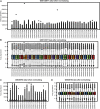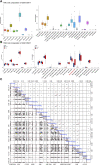Identification and Validation of Prognostic Factors of Lipid Metabolism in Obstructive Sleep Apnea
- PMID: 34880901
- PMCID: PMC8645574
- DOI: 10.3389/fgene.2021.747576
Identification and Validation of Prognostic Factors of Lipid Metabolism in Obstructive Sleep Apnea
Abstract
Background: Obstructive sleep apnea (OSA) is considered to be an independent factor affecting lipid metabolism. This study explored the relationship between immune genes and lipid metabolism in OSA. Methods: Immune-related Differentially Expressed Genes (DEGs) were identified by analyzing microarray data sets from the Gene Expression Omnibus (GEO) database. Subsequently, we conducted protein-protein interaction (PPI) network analysis and calculated their Gene Ontology (GO) semantic similarity. The GO, Kyoto Encyclopedia of Genes and Genomes (KEGG) pathways, Disease Ontology (DO), gene set enrichment analysis (GSEA), and gene set variation analysis (GSVA) were employed for functional enrichment analyses and to determine the most significant functional terms. Combined with the results of boruta and random forest, we selected predictors to build a prognostic model, along with seeking out the potential TFs and target drugs for the predictive genes. Results: Immune-related DEGs included 64 genes upregulated and 98 genes downregulated. The enrichment analysis might closely associate with cell adhesion and T cell-mediated immunity pathways and there were many DEGs involved in lipid and atherosclerosis signaling pathways. The highest-ranking hub gene in PPI network have been reported lowly expressed in OSA. In line with the enrichment analysis, DO analysis reveal that respiratory diseases may be associated with OSA besides immune system disorders. Consistent with the result of the KEGG pathway, the analysis of GSVA revealed that the pro-inflammation pathways are associated with OSA. Monocytes and CD8 T cells were the predominant immune cells in adipose tissue. We built a prognostic model with the top six genes, and the prognostic genes were involved in the polarization of macrophage and differentiation of T lymphocyte subsets. In vivo experimental verification revealed that EPGN, LGR5, NCK1 and VIP were significantly down-regulated while PGRMC2 was significantly up-regulated in mouse model of OSA. Conclusions: Our study demonstrated strong associations between immune genes and the development of dyslipidemia in OSA. This work promoted the molecular mechanisms and potential targets for the regulation of lipid metabolism in OSA.
Keywords: immunologic factors; lipid metabolism; macrophage activation; microarray analysis; obstructive sleep apnea.
Copyright © 2021 Peng, Wang and Bing.
Conflict of interest statement
The authors declare that the research was conducted in the absence of any commercial or financial relationships that could be construed as a potential conflict of interest.
Figures











Similar articles
-
Construction of a mitochondrial dysfunction related signature of diagnosed model to obstructive sleep apnea.Front Genet. 2022 Nov 21;13:1056691. doi: 10.3389/fgene.2022.1056691. eCollection 2022. Front Genet. 2022. PMID: 36468038 Free PMC article.
-
Identification of novel biomarkers in obstructive sleep apnea via integrated bioinformatics analysis and experimental validation.PeerJ. 2023 Dec 4;11:e16608. doi: 10.7717/peerj.16608. eCollection 2023. PeerJ. 2023. PMID: 38077447 Free PMC article.
-
Identification of Hub Genes in Patients with Alzheimer Disease and Obstructive Sleep Apnea Syndrome Using Integrated Bioinformatics Analysis.Int J Gen Med. 2021 Dec 9;14:9491-9502. doi: 10.2147/IJGM.S341078. eCollection 2021. Int J Gen Med. 2021. PMID: 34916831 Free PMC article.
-
Screening and identification of potential biomarkers for obstructive sleep apnea via microarray analysis.Medicine (Baltimore). 2021 Jan 29;100(4):e24435. doi: 10.1097/MD.0000000000024435. Medicine (Baltimore). 2021. PMID: 33530245 Free PMC article.
-
Possible genetic cross-talk between Down syndrome and obstructive sleep apnea revealed by transcriptomic analysis.Sleep Breath. 2023 Dec;27(6):2469-2478. doi: 10.1007/s11325-023-02845-w. Epub 2023 May 22. Sleep Breath. 2023. PMID: 37213066
Cited by
-
Identification of the Novel Gene Markers Based on the Gene Profile among Different Severity of Obstructive Sleep Apnea.Comput Math Methods Med. 2022 Oct 4;2022:6517965. doi: 10.1155/2022/6517965. eCollection 2022. Comput Math Methods Med. 2022. PMID: 36245838 Free PMC article.
-
CD40LG and GZMB were correlated with adipose tissue macrophage infiltration and involved in obstructive sleep apnea related metabolic dysregulation: Evidence from bioinformatics analysis.Front Genet. 2023 Feb 27;14:1128139. doi: 10.3389/fgene.2023.1128139. eCollection 2023. Front Genet. 2023. PMID: 36923793 Free PMC article.
-
Potential regulatory role of miRNA and mRNA link to metabolism affected by chronic intermittent hypoxia.Front Genet. 2022 Sep 6;13:963184. doi: 10.3389/fgene.2022.963184. eCollection 2022. Front Genet. 2022. PMID: 36147493 Free PMC article.
-
The genetic overlap and causal relationship between attention deficit hyperactivity disorder and obstructive sleep apnea: a large-scale genomewide cross-trait analysis.BMC Psychiatry. 2025 May 6;25(1):454. doi: 10.1186/s12888-025-06899-w. BMC Psychiatry. 2025. PMID: 40329273 Free PMC article.
References
LinkOut - more resources
Full Text Sources
Research Materials

